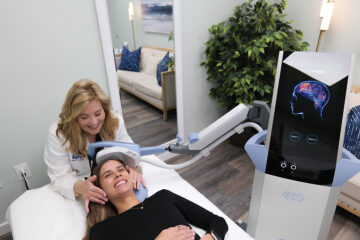Stretch It Out

We all know stretching and exercising go together, but not everybody understands why. Put simply, stretching returns muscles to their optimum resting length, helping to prevent injuries and increase flexibility. Sitting for hours at a desk, where muscles get tight, or exercising repeatedly without stretching, can cause a chronic shortening of the muscles.
This can create serious problems, as imbalance in one area affects the rest of the body, so any restricted movement affects global movement. Think about trying to run a marathon with one arm in a sling. Not easy. The most important rule to remember is: don’t stretch cold. You need to get the blood flowing around the muscles before you can truly benefit from stretching.
Before Your Workout
Prior to your workout, warm up your muscles by doing a lower-impact version of the exercise you are about to do. So, if you’re about to run, warm up with a five-minute jog, or if it’s a cycle, do five minutes on the cross-trainer to get the blood pumping around your legs and arms. Warming up this way increases the blood flow to the muscles you’re about to work and increases the synovial fluid around the joints to prepare them for a workout. Next, incorporate dynamic stretches (with movement) into your warm-up routine, as this will also help blood flow to the muscles. Dynamic stretches include hamstring curls, lunges, and arm swings.
Post-Workout
Following your workout, you should perform static stretches (ones without movement that you hold). These stretches are important to ensure your muscles are ready for your next workout. Stretching your muscles post-workout also helps to flush out lactic acid (a by-product of exercise). Post-exercise stretches are categorized into two parts: developmental and maintenance. Be sure to stretch your larger muscles and the ones that have worked hardest, for example, your front thighs (quads), back thighs (hamstrings), bottom (glutes), and shoulders (deltoids). Ensure you hold these stretches for between 15 and 30 seconds, breathing out on the stretch. When the stretch in the muscle eases, breathe in and out again and deepen the stretch even more. Smaller muscles like those in the arms (biceps and triceps) and calves can be stretched for eight to 15 seconds, again deepening the stretch as it eases. If any stretches hurt, stop immediately and rest.
Time Of The Month
Normal stretching rules don’t apply at the end of a woman’s menstrual cycle, just before her period arrives. At this time, women have greater amounts of the hormone relaxin in their bodies (just like during pregnancy when it is present in about ten times the normal concentration). This means the laxity of the joints is increased and therefore it is possible to over-stretch without realizing. So use caution.
Flexibility Differences
While it is very possible to increase flexibility through stretching, the truth is that some people are just more flexible than others. Some people are also chronically inflexible, and some are too flexible, instinctively moving their joints well beyond a normal range of motion (this is called hypermobility, and at its extreme can be very debilitating). If either of these conditions apply to you, it’s best to seek advice from a physiotherapist who can devise an exercise program that will help. LUCY FRY
Top Five Stretches For Women
1. Standing adductor stretch.
A great stretch if you tend to cross your legs a lot, as you’re likely to have weak glutes (bottom muscles) and tight adductors (inner thighs). With feet apart, lean to one side and hold for 15 seconds. You’ll feel the stretch on the opposite inner thigh. Repeat on the other side.
2. Calf stretch.
If you wear heels, your calves are likely to be tight. This inhibits flexibility, especially during squatting. To stretch them, stand on a step and drop one heel off the back. This stretches the fleshy part of the calf. After 15 seconds, bend your knee to take the stretch down into the lower part of the calf. Repeat on the other leg.
3. Hip flexor stretch.
Perform a lunge and place your back knee on the ground. With your pelvis neutral, feel the stretch in your hips and bottom and the front thigh of your back leg. Hold for 15 seconds and repeat on the other side.
4. Cat-camel stretch.
Kneel on all fours. Round your back and tuck pelvis under (camel). Next, do the opposite: look up and arch the back (cat). Repeat ten times.
5. Chest stretch.
Place your palms in the small of your back, then pull your elbows together behind you and hold for 15 seconds. Repeat if desired.







Comments